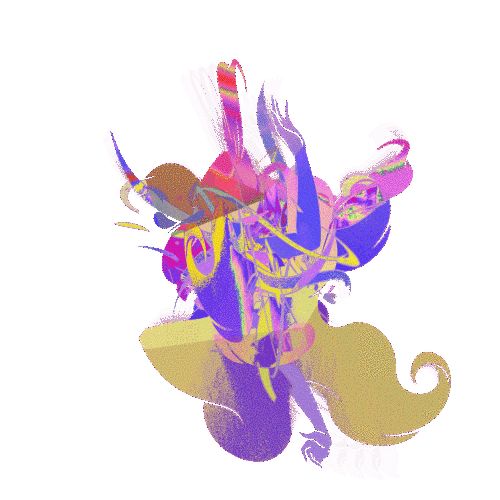
Entry: Seiyū
Seiyū
Characters in animation have had voices ever since Fleischer Studios released My Old Kentucky Home, the first talkie animation, in 1926. In Japan, actors who voice characters for anime are called seiyū. Their voices play a key, and necessary role in creating characters for this audio-visual medium.
In standard anime productions on TV, voice actors, by viewing the images, synchronise their voice acting with what the images depict. This method of voice recording is called afureko, a ‘Japanese English’ (wasei eigo) term meaning ‘after-recording’. Interestingly, voice recording occupies a different place in the production process depending on the country or region. For instance, in feature-length productions in the United States, the audio-recording process is conducted before visual production. Hence, this process is named ‘prescoring’.
Voice actors’ bodies, of course, are not shown to the audience in either prescore or afureko. However, the degree of discretion afforded to the voice actor differs between prescore and afureko. In prescore, since voice acting precedes visual direction, the voice offers the basis that animators rely on, and the reverse is so in afureko. Hence, the choice of prescore automatically means the prioritisation of voice acting over drawing, whereas choosing afureko means the prioritisation of drawing over voice acting. According to anime scholar and critic Ryōta Fujitsu, in afureko a director who creates storyboards determines the outline of a voice acting script for characters, and voice actors act following the script when recording; hereafter, this is called afureko script.[1] Because the afureko script is made from a storyboard drawn by a director, Fujitsu concludes that voice acting is “a work of assembling acting and expressing characters within a frame decided by others”.[2]
In my essay “Synchronising with Others: An Analysis of the Afureko Script”,[3] I analyse the afureko script in detail and show how it controls the voice acting. Here, I briefly summarise the points of that analysis. The comma ‘,’ in the afureko script indicates the timing of the character’s movements; that is, voice actors have to stop at the ‘,’ to synchronise with the character’s movement, and they cannot remove it nor change the location. The function of ‘,’ shows that voice actors must strictly follow the frame designed by the storyboards, at the minute or detailed level.
Because of the rigid frame imposed on voice acting, it has been said that the performance of voice actors is essentially different from that of actors in live theatre or non-animated cinema or TV dramas. Interestingly, such a bias existed even before the first TV anime series in the 30-minute weekly format, Tetsuwan Atomu (Astro Boy, 1963–1966), was broadcast.
Japanese Dubbing for Animations and Telefilms Produced in the US
Since the mid-1950s, many animations and telefilms have been imported to Japan from the United States, arousing a high demand for Japanese dubbing services for the first time. In dubbing, the voice actors have to carefully follow the timing of the original performance in English (or whatever language) for precise synchronisation; as a result, dubbing is called atereko in Japanese English, which means to match (ateru in Japanese) the voice to images in recording. In a script for atereko, lines are written to physically, or visually, correspond to the timing of the original performance. Yaeko Nukata, who has been a translator and scriptwriter for dubbing since 1956, explains how such a script is made.
“When the actor speaks the line in a breath, I have to write it in the dubbing script as it is, no matter how long the line is. On the other hand, when the actor speaks slowly with many pauses, I have to reproduce precisely the timing including pauses, no matter how short the line is.
For example, the actor speaks, putting breaks as follows:
‘He is my son. Whatever he is, my son.’
あれは (He is)
せがれだ (my son)
できそこないでも (Whatever he is )
せがれなんだ (my son)
If the actor for dubbing breathes at the place where the line changes, the dubbing matches the length of the original sound”.[4] Thus, dubbing and afureko share a similar system that gives cues to the voice actor to synchronise with the original.
The Argument on the Dubbing as Actor’s Job
In the early 1960s, some theatre and cinema actors began to criticise the practice of dubbing because the voice actors were brutally forced to follow the original actor’s performance.
On 19 February 1962, in the Tokyo Shimbun, a famous actor in the theatre, Eijirō Tōno, published his article on this issue, titled “Please Pay the Allowance to the ‘Voice’ Actors who Engage in Dubbing: They Are Suffering from Adjusting to Others Acting”. Tōno claimed that voice actors engaged in dubbing were miserable ‘marionettes’ because they just added their own voice to another actor’s original acting; he justified this argument as follows:
“In general, the actor’s work is to create a character in a unique way. Each actor performs this work in his or her own way. It cannot be replaced by another actor. I cannot stand that the actor’s voice is utilised for other actors’ performance”.[5]
Tōno also asserted that “actors who engage in dubbing should be paid more because they are at risk that their acting ability may be disabled”.[6] According to Tōno, dubbing is nothing but “a harmful job” for the actor.[7] In response to Tōno’s article, an actor, Tōru Abe, a voice actor engaged in dubbing for foreign telemovie series, published an article in the Tokyo Shimbun, issued on 26 February, titled “Dubbing and Actors”, in which he stated that the most important thing was to convey the feelings and personality of the other person through the dubbing in Japanese[8] and concluded that dubbing is also one of the actors’ jobs.
Next, another stage actor, Daijirō Natsukawa, published an objection to Abe’s opinion, again in the Tokyo Shimbun, on 5 March. Natsukawa insisted that “dubbing should not be taken as acting, because dubbing is just a skill” and further stated that those who have experienced certain vocal training, such as落語家 rakugo-ka (traditional comical storyteller), newscaster, or tour guide training, are also suitable for dubbing.[9]
This controversy was caused by the fact that all performing arts and communication include vocal expressions; at the same time, however, it tells us that the state and nature of voice acting can vary according to changes in the media environment: with the advent of TV broadcasting, dubbing newly became a part of the field and craft of voice acting.
To ‘Act Anime Characters’: The Case of Ichirō Nagai
Among actors themselves, voice actors who engaged in afureko for anime received the same kind of evaluation as voice actors for dubbing. In afureko, even though the voice actor’s performance creates the vocal aspect of the character, voice actors need to synchronise with the animators who draw the visual aspects of characters, prior to voice acting. In addition, as noted, voice actors in afureko are visually absent–whereas, in contrast, from the traditional point of view, acting means embodying the whole character, using one’s body and face and showing them to the audience. In this light, voice actors for anime seemed to lack something important for acting and came to occupy a low position in the actorly hierarchy.
In 1981, 20 years after the argument on dubbing, a famous voice actor with a long career in anime, Ichirō Nagai, published an article on voice acting for anime, “Saibō de toraeta engi’” (“Acting by the Level of Cells”).[10] This article was a contribution to a fan book for the series Mobile Suit Gundam (1979), of which Nagai was the narrator. The basic assumption of the article is that acting for anime is not different from acting for theatre; therefore, Nagai does not use the expression ‘voice actor’ so often, but just simply ‘actor’. In addition, he analyses what and how anime actors think of the performance in afureko, referring to the criticism of dubbing by Tōno and Natsukawa but insisting on his own opinion.
According to Nagai, actors should “match their own cell’s vectors to the character’s vectors”.[11] In his context, ‘cell’ stands for a certain physical reality of the actor’s body, and ‘vector’, borrowed from physics, stands for the necessary measures to grasp characters. He states that voice actors need to understand the vector of characters’ emotions and that of their actions, motivated and realised by means of their feelings. In other words, voice actors must completely comprehend the vectors of the reasons, backgrounds, and environments that construct the character’s actions and turn these vectors into the actor’s own vectors.
Nagai explains an advisable way to read the script, as follows.
“The actors need to pick up the vectors of the conditions necessary for the characters from the script as much as possible. Otherwise, the character’s actions performed by the actors are not precise. When the actors insufficiently and incorrectly prepare the conditions of action at the cell level, they do not fit the characters. The actor’s talents depend on the ability to pick up the vectors”.[12]
Moreover, Nagai states that actors in afureko simulate their character’s behaviours, and that as a result, the actors can embody the character’s movements even if they themselves do not move in front of the microphone. He explains his own experience in afureko.
“In other words, I was actually just watching the character’s movements on the screen and lip-syncing, but I tried to imagine myself acting the character’s movements more consciously and more strongly. This process was repeated again. I was able to consciously create feelings that occurred in my own cells. At that time, my work did well. The lines of the character were lively spoken”.[13]
In the context of Nagai’s acting theory, I now focus on a phrase acted by Nagai in Episode 33—“Kāsan ga inai” (“Mother has disappeared”)—of the show Haha wo tazunete sanzenri (1976). In this anime work, Nagai plays Peppino, the leader of a travelling puppet troupe. When Peppino arrives at an inn in a small town, he speaks the line.
ペッピーノ「やれやれ(yare yare)、これで手足がのばせる」
Peppino: ‘Well done (yare yare), I can relax’.[14]
In this cut, Peppino’s line, “やれやれ” (yare yare), is articulated not only by the onomatopoeic word yare yare but by a sigh integrated with it; this not only conveys that Peppino has finally arrived at the inn following a long journey but also that he is experiencing the hardships and sorrows of a travelling artist. Of course, this breathing can be performed quite precisely relying on the timing of the comma, discussed above. Moreover, Nagai manipulates his breath while remaining in the frame imposed by the storyboard, adds various nuances into his voice, and conveys the character’s innermost feelings, literally breathing life into the character.
Peppino’s sigh also reflects Nagai’s action to physically grasp the actions of the characters, and is an example of Nagai’s acting theory and practice. In addition to his own acting experience, Nagai was theoretically armed with an academic article by the athletic scholar Atsushi Katsube, based on which he argues against the suspicion of voice acting shared by many actors in theatre,[15] founded on the view, hinted at above, that voice acting is inauthentic and voice actors cannot act by their own 息 (iki, “breath”).
Interestingly, Nagai also asserts that “the actor’s own 息” considered an essential factor in stage acting. He says that “if you really act by your own息, it does not mean to ‘become a character”’.[16] Besides, he points out that “in the atereco for anime (note 1: this reference shows how dubbing for American programmes and afureko for anime were both lumped together as voice actor’s jobs), lip-synching is a direction made by a director. The lip-synching, as an instruction, is much more accurate and useful than an incompetent director”.[17] Nagai insists that “the visual aspects of characters certainly exist before [their] voice. However, they are just shadows without their voice. Please turn off the volume of your TV set. Then, characters on the screen are no longer ‘human”’.[18] From Nagai’s understanding of voice acting for afureko in anime, we can infer that the voice is as important as the picture for bringing characters a lively or compelling existence on the screen.
Nagai clarified that both voice and visual aspects are necessary to bring characters to life in the narrative world, and strongly affirmed the meaning and value of contributions by voice actors engaged in the afureko. His assertion is proof that voice actors even at that relatively early stage clearly identified and recognised the voice actor’s job as an essential factor in the new rising audio-visual medium of anime. Nagai’s article, “Acting at the Level of Cells”, was written for fans of Mobile Suit Gundam and for young people who wanted to be voice actors in anime; especially in this context, Nagai’s confidence and pride as a voice actor eloquently indicate that anime already stood in Japanese society as an expressive, mature medium comparable to theatre and cinema.
Minori Ishida
[1] Fujitsu, 2018: 100–3. Fujitsu, Ryōta. “Seiyū ron: Tsūshiteki, jisshōteki ichi kōsatsu”. In Anime kenkyū nyūmon ōyōhen: Anime wo kiwameru 11 no kotsu. Edited by Masahiro Koyama and Akiko Sugawa, 93–117. Tokyo: Gendai Shokan, 2018.
[2] Fujitsu, 2018: 103.
[3] Ishida, 2020.
Ishida, Minori. “Voice actors synchronised with other human agents: An analysis of the afureko script”. In Archiving movements: short essays on anime and visual media materials vol. 2. Edited by Ishida, Minori and Kim Joon Yang, 33–40. Niigata: The Archive Center for Anime Studies at Niigata University, 2020.
[4] Nukata 1989: 40; all translations from Japanese by the present author.
Nukata, Yaeko. Atereko arekore: Terebi eiga honyaku no sekai. Tokyo: Chūokōron Sha, 1989.
[5] Tōno, 1962. Tōno, Eijirō. “Seiyū ni kiken teate wo: Tanin no engi ni awasu kurushimi”. Tokyo Shimbun. 19 February 1962.
[6] Tōno, ibid.
[7] Tōno, ibid.
[8] Abe, Tōru. “Atereko to haiyū: katawa ni naru towa omowa nai”. Tokyo Shimbun. 26 February 1962.
[9] Natsukawa, 1962. Natsukawa, Daijirō. “Biginesu to warikire: Atereko wa tokushuna gijutu”. Tokyo Shimbun, 5 March 1962.
[10] Nagai, Ichirō. “Saibō de toraeta engi”. Gundam Century: Sora kakeru senshitachi Fukkoku ban: 88–96. Tokyo: Jusōsya, 1981=2001.
[11] Nagai, 1981=2001: 94.
[12] Nagai, ibid. 92.
[13] Nagai, ibid. 93.
[14] The afureko script for ‘Episode 33,’ 1976: 14.
This afureko script is part of the Watanabe Collection at the Archive Center for Anime Studies at Niigaa University, which includes several kinds of intermediate materials produced and used to make soundtracks for anime works.
[15] Nagai, 1981=2001: 94.
[16] Nagai, ibid. 94.
[17] Nagai, ibid. 94.
[18] Nagai, ibid. 90.
Dr. Ishida Minori is Associate Professor at Niigata University and Co-director of the Archive Center for Anime Studies in Niigata University. Her research field is visual and audio cultures focusing on voice and gender in anime. She has published Anime to seiyū no media shi: naze josei ga shōnen o enjirunoka [Media History of Anime and Voice actors: Why Voice Actresses Play Roles of Boy?] (Tokyo: Seikyūsha, 2020) and Hisoyaka na kyoiku:“Yaoi -Boys Love”zenshi [Secret Education: Prehistory of Yaoi and Boys’ Love] (Kyoto: Rakuhoku Shuppann) for which she received the Abe Prize from Niigata University in 2009; besides contributing articles around ‘Deviating Voices’ or ‘Sounds and Sighs: “Voice Porn” for Women’.



